Yesterday, my son woke up, walked out of the room and immediately signed “hungry”. He then walked into the kitchen and pointed to his apron and signed for putting it on. I handed it to him (I need to install a lower hook), he put it on and proceeded to pull out his kitchen helper and then pointed to the fridge and said “egg!” He is 16 months old now. I love that instead of crying or waiting passively, he is able to express his need and even do something about it. This scenario illustrates one of the many reasons I love what Montessorians refer to as practical life activities.
These are activities that involve the child in daily life and help him develop skills for maintaining and caring for himself, others, and his environment. They also help him to adapt to the social life and expectations of his time and place. Here’s an example to illustrate some of the benefits of Practical Life.
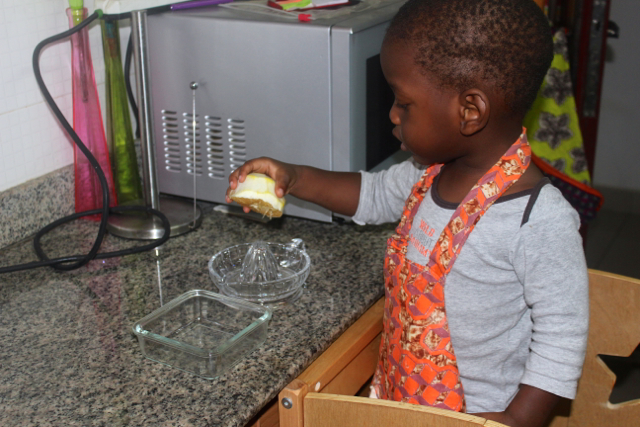
Building Vocabulary: Practical life activities provide opportunities for the child to learn many words including names of fruits, vegetables, tools, utensils etc. They not only know the name but they know what they are because they get to touch, smell, taste, use and really understand them. In juicing an orange, the child learns what an orange is, what it looks like before and after peeling. What the inside looks and smells like, that it has juice, seeds and chaff. He learns what a juicer is and what it looks like. He learns that it has a handle, a reamer and a spout.
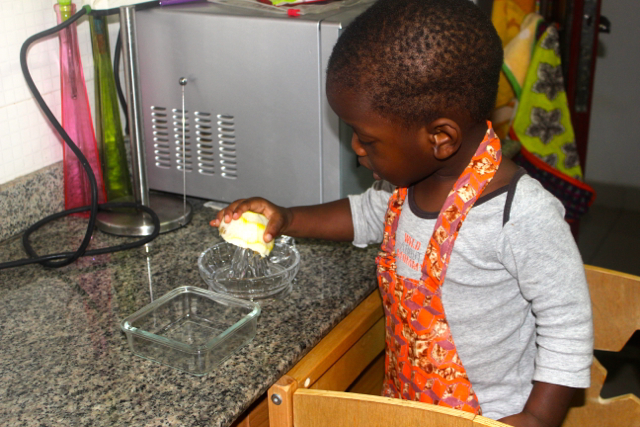
Functional Independence and visual discrimination: Practical Life activities provide opportunities for the child to look at objects and notice the difference. To analyze and make decisions… these small decisions prepare him for big decisions in the future. Which side of the orange should face down? how do I center it on the reamer?
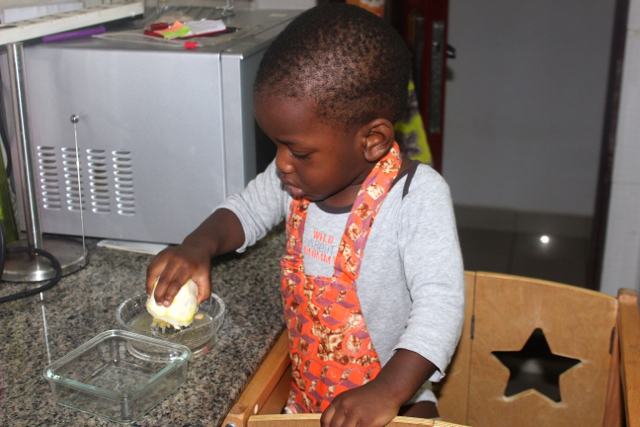
Strengthening of the hands: Maria Montessori said that the hands are the instruments of man’s intelligence. They need to be strengthened and precise to prepare for future use in writing, stitching, building, painting, playing an instrument etc. Juicing an orange require the child to press and squeeze… both movements help strengthen the hands.
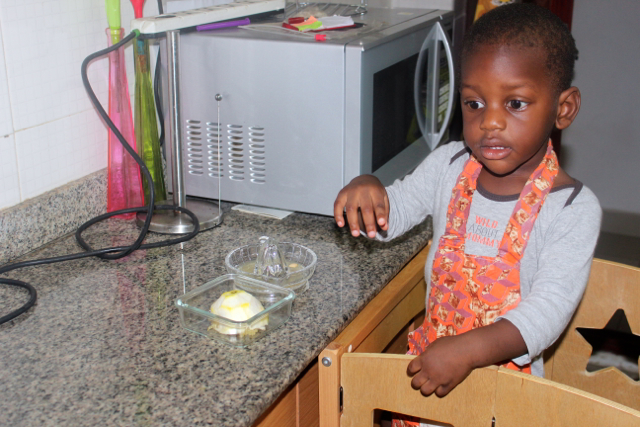
Order and Sequencing: Many situations in life and academics require order and sequences. Practical life activities often include processes/ a specific sequence of actions and require order/ a place for everything. After squeezing, you put the orange in the bowl and then you need the pitcher. The child internalizes this process and order every time he repeats the activity. I’m done squeezing… may I have the pitcher?
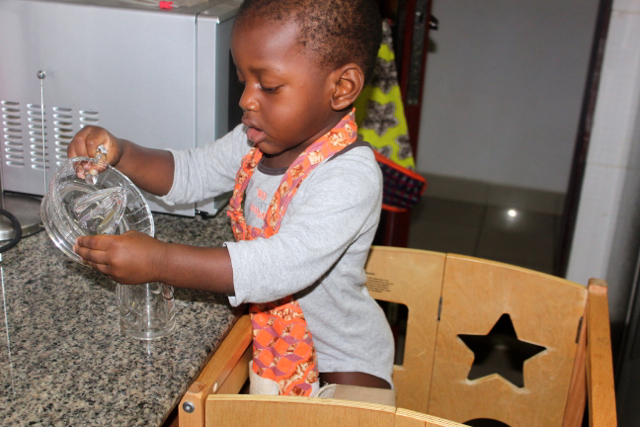
Gentleness, Precision: Hand-Eye Coordination: By allowing him to work with real tools made of glass, the child learns to be gentle and handle them with care. Pouring from the wide mouthed juicer without a lid into the narrow mouthed pitcher helps with the development of hand-eye coordination and precision. With practice he has learnt to pour without spilling. If he had spilled some, he would have known how to wipe it up.
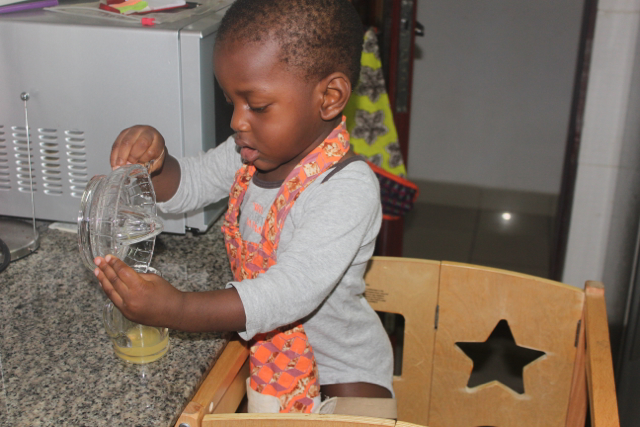
Understanding of quantities and preparation for math: Practical life activities provide plenty opportunities for counting, quantity recognition, fractions, volume, sets and many other math concepts to be absorbed concretely. He juiced “half” of “one” orange and pours the juice into the pitcher until the juicer is “empty”.
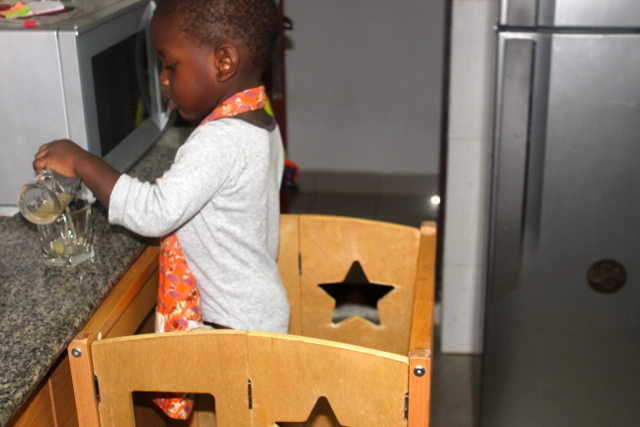
Social Etiquette: Practical life activities provide a lot of opportunities to learn and practice social etiquette. You drink from the glass, not a pitcher and so you have to pour from the glass into the pitcher and this time, you don’t have to empty the pitcher… just pour as much as you need.

The rewards are built in. He knows he is capable of satiating his thirst. He has learnt to concentrate, delay gratification and go through the process to enjoy the fruits of his labor.
For more ideas, see other practical life activities for a toddler, baking cookies, making almond milk – video, making almond milk – recipe, baking banana bread
Tomorrow’s post will include some ideas for starting out kitchen practical activities with your toddler.
Join the conversation and Live a Good Life!





12 Comments
Christine Laubin · January 8, 2015 at 5:17 pm
Nduoma you have such a good way of explaining Montessori principles from the ground of everyday living. I am really appreciating your blog, and recommending it to others.
nduoma · January 17, 2015 at 12:27 pm
Thank you Christine for reading, commenting and sharing!
Christine · January 8, 2015 at 10:26 pm
This really is one of my favorite Montessori blogs! Such an inspiration 🙂
nduoma · January 17, 2015 at 12:27 pm
Thank you Christine!
marysmontessorischool · January 9, 2015 at 1:52 pm
Reblogged this on Mary's Montessori School and commented:
Oh my gosh, this guy is so cute! And orange juice squeezing is THE most popular work at school. 🙂
nduoma · January 17, 2015 at 12:26 pm
Thank you! It was also very popular when I was running a toddler class.
Vk · January 13, 2015 at 11:46 pm
Very Impressive and Awesome explanation of the process.. It very well explains the ways kids handle the situation and moreover helps me to really understand and enjoy what they do.
nduoma · January 17, 2015 at 12:20 pm
I am glad you find the explanation helpful VK! Thank you for the comment.
Isa · January 14, 2015 at 9:23 am
It’s really impressing to see how much your son is focused and dedicated to what he is doing! I have a question, where did you find the wooden thing you use to have him by your side while cooking? And what’s its name?
nduoma · January 17, 2015 at 12:14 pm
Thank you Isa. It is the Kitchen Helper by Guidecraft. We bought it off Amazon. Kylie at How we montessori recently did a lovely roundup of options. You may find it helpful.
Isa · January 17, 2015 at 3:07 pm
That’s perfect, we’ll try to build one for our daughter. Thanks a lot for your wonderful and inspiring posts!
Cooking with a Toddler: Making an Omelette | · January 17, 2015 at 11:29 am
[…] considerations in action. It’s definitely faster to make it yourself but hopefully the benefits to the child and the development of concentration are […]